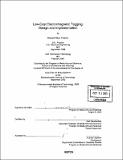Low-cost electromagnetic tagging : design and implementation
Author(s)
Fletcher, Richard R. (Richard Ribon)
DownloadFull printable version (29.21Mb)
Other Contributors
Massachusetts Institute of Technology. Dept. of Architecture. Program in Media Arts and Sciences.
Advisor
Neil Gershenfeld.
Terms of use
Metadata
Show full item recordAbstract
Several implementations of chipless RFID (Radio Frequency Identification) tags are presented and discussed as low-cost alternatives to chip-based RFID tags and sensors. An overview of present-day near-field electromagnetic tagging is presented, including both chip-based and chipless technologies with associated costs. As a candidate for low-cost ID tags, a design theory and implementation is presented for multiply-resonant planar metal structures. This theory includes a circuit model, a phenomenological model, and a framework for predicting the resonant frequencies as a function of geometrical and material properties. A novel physical geometry, a tree-like spiral structure, is proposed as a design that increases the number of resonances per unit area in a planar structure relative to the present day state-of-the-art. In addition to identification, it is shown how several chipless tags can also be designed to function as sensors. Several examples are discussed in detail, including: 1) a family of thermal sensor tags employing magnetic materials and 2) a family of sensor tags (to sense pressure, humidity, and pH) based on planar resonator structures. The latter section of the dissertation describes the evolution of my work in developing the necessary (and low-cost) instrumentation to support these new varieties of tag technologies, ranging from a $500 frequency-agile reader to a $5 reader for toy applications.
Description
Thesis (Ph. D.)--Massachusetts Institute of Technology, School of Architecture and Planning, Program in Media Arts and Sciences, 2002. Includes bibliographical references (p. 220-222).
Date issued
2002Department
Program in Media Arts and Sciences (Massachusetts Institute of Technology)Publisher
Massachusetts Institute of Technology
Keywords
Architecture. Program in Media Arts and Sciences.